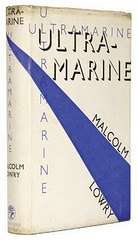Ultramarine (novel)

(publ. Jonathan Cape)
Ultramarine is the first novel by English writer Malcolm Lowry. Published in 1933, the novel follows a young man aboard a steamer in the early 20th century and his struggle to gain acceptance from his crew mates. Lowry tinkered with the novel until his death, adapting it also to make it fit with his second novel, Under the Volcano (1947).
Plot
Ultramarine is the story of Dana Hilliot, a young man of a well-to-do family who signs up to sail to the Far East on the Oedipus Tyrannus. The crew, and especially Andy, the "chinless cook", don't readily accept him as one of theirs because Dana is from a different socio-economic class: they all saw how his father, driving a luxury car, dropped him off at the ship, and they know that Dana doesn't need to work for a living as they do. Moreover, Dana is a mess-boy who is not particularly good at his work. The novel's action comes to a head when during shore leave, Dana has found enough courage in liquor to insult Andy, after which the two develop a kind of friendship. Along the way, Dana writes to and pines for his virginal girlfriend back home, Janet; his dedication to her is another challenge to him during shore leave, when his crew mates visit bars and brothels.
Background and development
The novel was written from Lowry's own experience; he had sailed at age 18, starting as a deck hand, on a tramp steamer, and like Hilliot he had gotten permission from his father to delay entrance into university and go to sea for a year. Like Hiliot, Lowry was dropped off at the quay from the family limousine.
Lowry's notes made during his voyage were the basis for two short stories (his first publications) that appeared in Experiment, a Cambridge magazine, in the early 1930s. According to Margerie Bonner, Lowry's wife and editor, these two stories were worked into the novel Ultramarine. The history of the novel's manuscript is muddled and contradictory: Lowry said he'd finished the novel at a friend's house but lost the manuscript, and the friend, Martin Case, later claimed to have found it in his trash can; according to Conrad Aiken, Lowry's idol and friend, a version was kept at his house and Lowry knew about it. The novel was published in 1933 by Jonathan Cape. Afterward, the name of the ship was changed from Nawab to Oedipus Tyrannus, "to conform with Hugh's ship in Under the Volcano."[1]